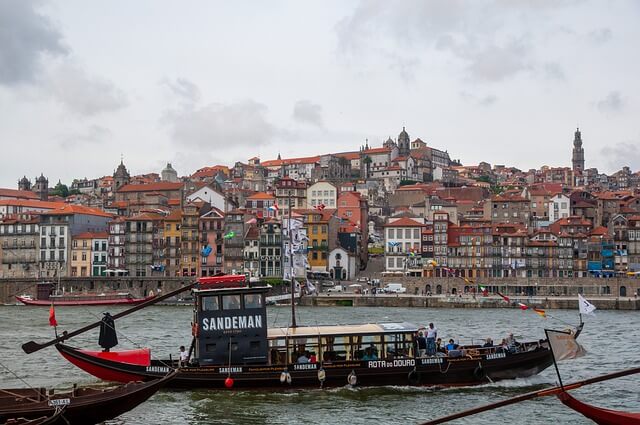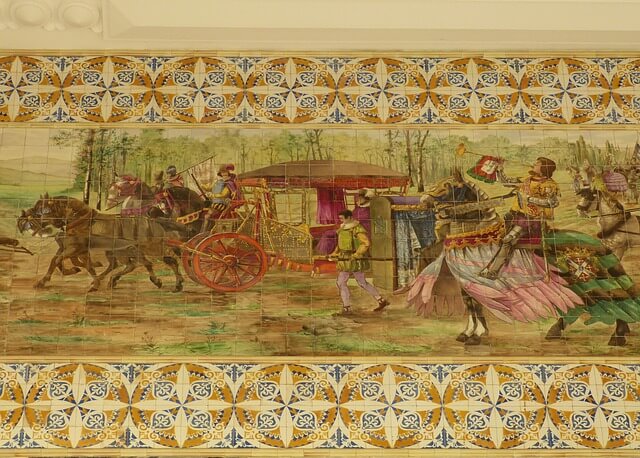Port Wines Near Porto, Portugal
Bliss in a Bottle from
the Douro Valley
By Lucia Byttebier

|
|
The colorful city of Porto in Portugal.
|
Walking out from a dark, silent alley onto Porto's bustling seafood-scented Ribeira, one immediately understands why this city is a hidden gem of the Iberian Peninsula. Many ochre and brick-colored houses sprout from the deep gorge to the River Douro. As it coils and turns out towards the ocean, crossed by six immense bridges, pinnacles of 19th — and 20th-century engineering, it's no wonder Porto has earned the title "city of bridges."
However, Porto, in northern Portugal, has many names and titles, particularly since UNESCO named it a World Heritage Site. Its baroque, gothic, and Renaissance facades decorated with stunning blue and white ceramic tile work, or azulejos, dominate the city's historic center. People peer out from their windows or balconies, garlanded by the day's washing, swaying in unison. The streets dip and rise, creating spectacular visuals of a town that seems to have halted in time.

|
|
Azulejo in Porto.
|
The Scenic Douro Valley and River Douro
A scenic walk across the River Douro on the Don Luis I bridge will take you to Vila Nova da Gaia, whose riverfront is a tourist hot spot. A significant change from the traditional seafood eateries on the other side, Gaia offers trendy experiences in hip restaurants and riverside cafés. But Porto is most famous for its port wine cellars and lodges. People from all over Europe congregate here, at the birthplace of port wine, for a taste of this seductive yet noble drink.
The Douro Valley is nothing short of an earthly paradise, stretching 100 km from Porto through terraced vineyards cascading down into the river and undulating along the mountainous terrain. In this demarcated region with different altitudes and microclimates, the 30 varieties of grapes for port are grown and seldom found elsewhere. Some are grown as far up as 1,800 meters, but experience tells us that lower elevations are best, where the grapes can feel the river flowing.
The port wine region is divided into three zones: the Baixo Corgo, the Cima Corgo, and the Douro Superior. Each zone has remarkable climatic conditions that vary throughout the year, determining the quality of the grapes. Small-scale variations in the temperature or rainfall can make or break a harvest. For example, the Baixo zone is closest to the Atlantic, receiving the most rainfall, making it a fertile and bearing land. The Douro Superior is the hottest and driest region of the three.
A miracle of agricultural engineering has been necessary to succeed in creating vineyards here on the steep slopes of the Douro Valley. The terraces on which the vines flourish lay on sedimentary rocks known as schist, which have been molded using dynamite or bulldozers, but a century ago was done by the hard toil of men and women of the trade. The loose, dry soil could look better, but it's perfect for the vines to push down their roots to find water. This poor-quality soil and the extraordinary climatic fluctuations make this region a wine heaven.
The English Turn Up
Interestingly, English wine traders saw the enormous potential of the Douro Valley. Driven by their shortage of Bordeaux wine due to frequent wars in the 17th century, British wine merchants turned to Portugal for an alternative to the French wines they loved. However, the quality they found in Portugal did not match their expectations, so they decided to oversee the production of wine worthy of a British palate.
The historical influence is apparent when one walks along the Gaia riverside, as the names of the extensive port cellars are English. Taylor's, Croft, and Sandeman are among the large English porthouses popular today in Porto. They offer tours of their age-old cellars and some port tastings for enthusiastic tourists and wine lovers. A tour costs anywhere from nothing to €6 and is in Portuguese, Spanish, or English, with frequent groups leaving every half hour or so.

|
|
Enjoying some glasses of Port.
|
The Sandeman Port Tasting Tour
The Sandeman tour is one of the most interesting. You are greeted by a dark-caped tour guide resembling the image of the infamous Don Sandeman trademark logo, whose design was created in the 1920s, representing the traditional black capes of Portuguese students. As soon as you step into the extensive cellars, the smell of old oak and fermented fruit mixed with their pleasant coolness and humidity is intense. Barrels, drums, and casks are piled up across the warehouses, all containing the vintages brought here from the Quintas to start the aging process.
The tour ends in a large hall with intimate dim lighting and long black tables, where glasses of white and red port sit in each place. The tour guide bids everyone salud. Then you hear instant clinks of the crystal, followed by a mellow silence. Everyone swirls the port in their mouths for a few seconds and finally swallows. Some taste port for the first time, while others savor their favorite wine. Either way, the experience is a hedonistic thrill, putting Bacchus himself to shame. The fine white port has a pale lemon color with lovely pear and apple notes. The red port has a sensual, deep, ruby color with a brown sugar nose and sweet cherry and plum notes. Bliss.
The Three Types of Port
There are three main types of red port: vintage, Tawny, and Ruby. Ruby ports spend at least two years in huge vats before being bottled. These immense vessels minimize the air that comes in contact with the wine through the wood, reducing oxidation. This process yields a bright garnet or ruby-colored wine with berry fruit overtones. Ruby ports are best enjoyed postprandially with red or black fruits and light cheeses, perfect for desserts with chocolate.
Tawny ports are aged in smaller barrels, allowing more air to contact the wine and creating more oxidization. As the name implies, Tawny ports have a deep mahogany color with overtones of almonds and spices. Ideally, you enjoy this port after dinner with more pungent cheeses, such as Roquefort, nuts, or dried fruits.
Vintage ports are the most expensive kind of port. They are a higher-quality ruby port in oak casks, ages four to six years. These ports must be decanted before drinking to allow the remaining sediments to sink. This type of port will continue aging in the bottle, and Sandeman boasts of having a 100-year-old bottle from 1906 that costs €3,000.
There are also white ports, which aren't as popular as their red counterparts but can be just as good. They can range from very sweet to dry and ideally are chilled to be an aperitif to any meal. The white port has a citric tang with light floral hints, which can be enjoyed alone, on the rocks, or combined with tonic water and a wedge of lime.
The Calem Port Tasting Tour
The house of Calem is another large wine lodge that is family-owned and, more importantly, Portuguese family-owned, which is why many locals recommend it. The tour around its award-winning 19th-century cellars is short but informative, showing off the impressive 57,000-liter oak vats, some of which are as old as the business. Oddly enough, some of the smaller oak barrels are exported up to Scotland after they've served their function with port to continue their storage career, this time with whiskey.
Port is a fortified wine, meaning adding brandy halts its natural fermentation process. The brandy stops the grape's sugars from turning into alcohol, thus giving the final product its sweetened characteristic and between 19 and 22 degrees of alcohol — almost double that of average table wine. How this process came to be is unknown, although word on the street is that monks in Portuguese monasteries were mixing wine with brandy to make it sweet for centuries before the English came. The port creators added a bit of brandy to stabilize the wine during the long sea journey to the British Isles.
The Croft Port Tasting Tour
Uphill away from the river promenade, a labyrinth of steep, sunlit cobblestone streets leads to port houses, such as Taylor's, Offley, and Croft, between the traditional tiled rooftops and iron street lamps. The view of Porto from some of these wine warehouses makes for a worthy companion when tasting their port. Such is the case of Croft, whose tasting room is decorated with old barrels and traditional grape-picking tools, and looks out over stunning scenery.
Walking out from the wine lodge, Porto appears across the river under the sun's glow behind a low hill. Back in the Porto Riviera, the restaurants are already spreading their tablecloths, and the pungent smell of fried calamari fills the air. In the city center, the Brazilian gold of the church mosaics and the marble of the steeples highlight the power and wealth that Porto once had when the port trade made it flourish. So, one shouldn't be surprised that the country itself was named after a city that thrived on sweet, succulent wine. The history of port illustrates how a bit of bliss in a bottle can go a long way.
Lucia Byttebier is an Argentine freelance travel writer who has traveled around Europe.
|
